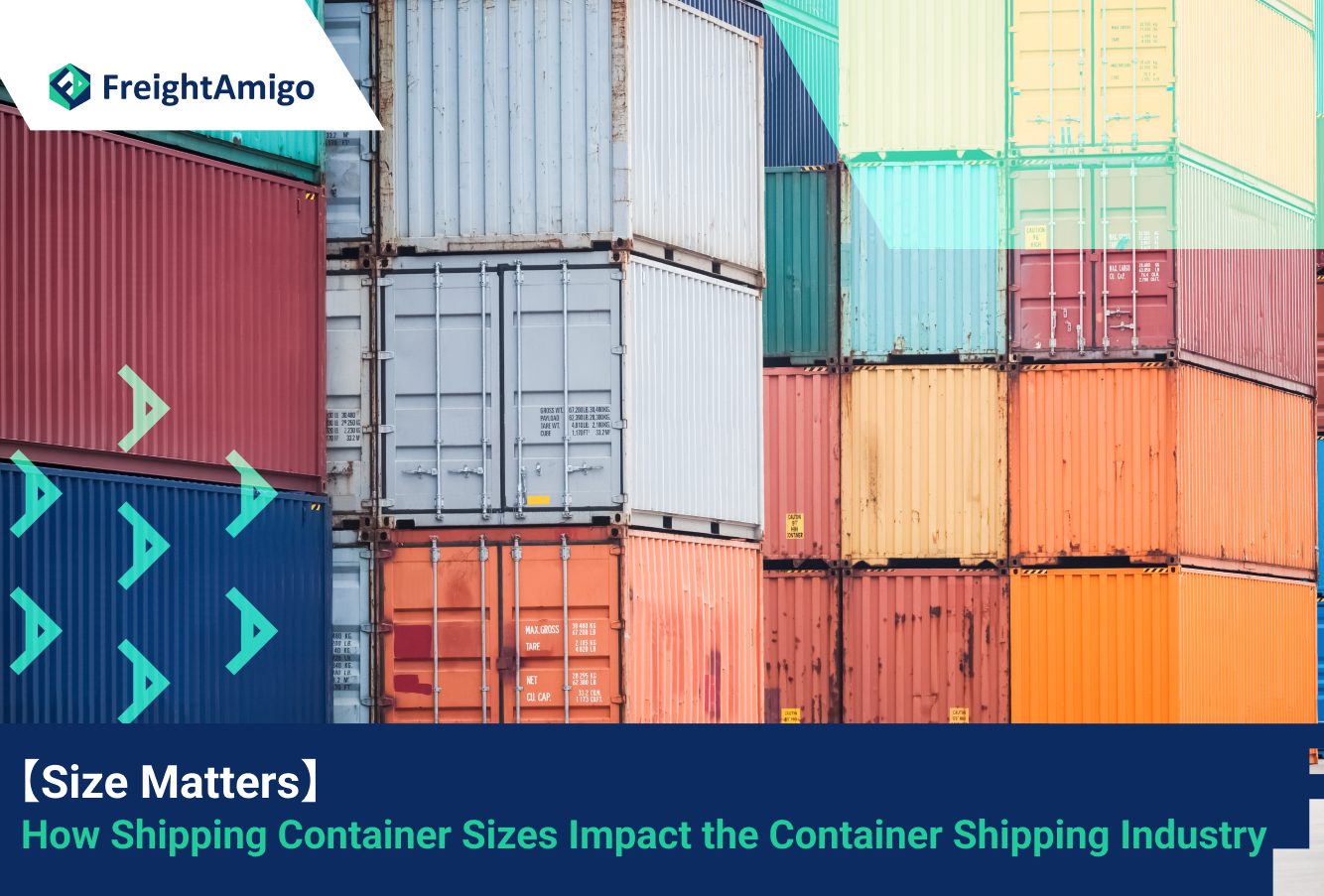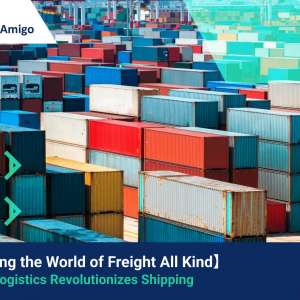Author Name: Tiffany Lee – Marketing Analyst at FreightAmigo
Introduction to Shipping Container Sizes
The shipping industry is a vital component of global trade, transporting goods across the world’s oceans. Central to this industry are shipping containers, which come in various sizes and play a significant role in determining the efficiency and cost-effectiveness of transporting goods. Understanding the impact of shipping container sizes on the industry is crucial for businesses and individuals involved in international trade. In this article, we will delve into the importance of shipping container sizes, their impact on industry costs, and future trends in container sizing.
Shipping containers are standardized rectangular metal boxes used for the efficient and secure transportation of goods. They are available in different sizes, with the most common being 20 feet and 40 feet in length, and 8 feet in width and height. Additionally, there are high cube containers that offer extra height, and specialized containers for specific cargo types. The choice of container size depends on the volume and nature of the goods being transported, as well as the mode of transportation, such as ships, trains, or trucks.
Want To Compare The Best Express, Air Freight, Sea Freight, Rail Freight & Trucking Rates So As To Have Better Control On Cost?
Standard Shipping Container Sizes and Dimensions
The two primary standard shipping container sizes are the 20-foot and 40-foot containers, known as TEU (Twenty-foot Equivalent Unit) and FEU (Forty-foot Equivalent Unit) respectively. The 20-foot container measures 20 feet in length, 8 feet in width, and 8 feet 6 inches in height, providing a capacity of approximately 1,170 cubic feet. On the other hand, the 40-foot container has double the length of the 20-foot container, with similar width and height dimensions, offering a capacity of around 2,390 cubic feet. These standard sizes have become the industry norm, allowing for efficient loading, stacking, and transportation of goods across different modes of transport.
In addition to the standard sizes, there are variations such as high cube containers, which offer an increased height of 9 feet 6 inches, providing extra space for bulkier or taller cargo. There are also specialized containers designed for specific goods, including refrigerated containers for perishable items, open-top containers for oversized cargo, and flat rack containers for heavy machinery and equipment. These variations in size and design cater to the diverse needs of shippers and contribute to the flexibility of the container shipping industry.
Impact of Shipping Container Sizes on Industry Costs
The choice of shipping container size directly influences the costs associated with transporting goods. Larger containers, such as the 40-foot and high cube containers, allow for the consolidation of more goods into a single unit, reducing the overall shipping cost per item. This is particularly advantageous for bulk cargo and larger shipments, where maximizing container space leads to economies of scale and lower transportation expenses. On the other hand, smaller containers may be more suitable for smaller shipments or goods that require separate handling and storage.
Efficient utilization of container space is crucial for cost optimization in the container shipping industry. Proper planning and packing of goods to fit the available container size can minimize wasted space and reduce the need for additional containers, ultimately lowering the overall shipping costs. Furthermore, the compatibility of container sizes with standard transportation equipment, such as trucks and rail cars, affects the efficiency of cargo transfer and contributes to cost savings throughout the logistics chain.
Factors Affecting Shipping Container Prices
Several factors influence the prices of shipping containers, including their size, condition, and demand in the market. Larger containers generally command higher prices due to their increased capacity and versatility in accommodating various types of cargo. The condition of the container, whether new or used, also plays a significant role in determining its price. New containers, especially those of standard sizes, come with a premium cost, while used containers may offer a more cost-effective option for certain shipping needs.
Market demand for shipping containers fluctuates based on global trade patterns, economic growth, and industry trends. During periods of high demand, such as peak shipping seasons, the prices of containers, especially the standard sizes, may experience upward pressure due to limited availability. Conversely, in times of low demand or surplus container inventory, prices may become more competitive, presenting cost-saving opportunities for shippers and logistics providers.
Cost-Effective Shipping Container Solutions
To mitigate the impact of shipping container prices on overall logistics costs, businesses and individuals can explore cost-effective solutions tailored to their specific shipping requirements. One approach is to optimize cargo consolidation by strategically selecting the appropriate container sizes based on the volume and nature of the goods being transported. By maximizing the use of available container space and minimizing empty or underutilized areas, shippers can achieve greater cost efficiency and reduce the need for additional containers.
Another cost-effective solution involves considering the use of used shipping containers, which can offer substantial savings compared to purchasing new ones. Used containers, especially those in good condition, provide a reliable and affordable alternative for various shipping needs. Additionally, exploring leasing options for shipping containers can provide flexibility and cost advantages, particularly for short-term or temporary shipping arrangements. By evaluating these cost-effective solutions, businesses can optimize their shipping operations and achieve greater financial efficiency.
Future Trends in Shipping Container Sizes
The container shipping industry continues to evolve, driven by technological advancements, changing trade patterns, and sustainability considerations. Future trends in shipping container sizes are expected to focus on enhancing efficiency, reducing environmental impact, and accommodating evolving cargo requirements. One prominent trend is the development of innovative container designs that maximize space utilization while minimizing weight, contributing to fuel savings and lower emissions during transportation.
Furthermore, the integration of smart technologies and IoT (Internet of Things) capabilities into shipping containers is poised to revolutionize the industry. Smart containers equipped with sensors for monitoring temperature, humidity, and location provide real-time visibility and control over cargo, ensuring optimal conditions and security throughout the shipping process. This trend towards smart and connected containers aligns with the industry’s drive for greater transparency, traceability, and efficiency in the handling of goods.
Conclusion: The Importance of Choosing the Right Shipping Container Size
In conclusion, the size of shipping containers plays a crucial role in shaping the container shipping industry, influencing costs, efficiency, and overall logistics performance. Understanding the impact of shipping container sizes on industry costs and exploring cost-effective solutions are essential for businesses and individuals engaged in global trade. By embracing future trends in container sizing and making informed decisions regarding container size selection, stakeholders in the shipping industry can optimize their operations and contribute to sustainable and competitive supply chains.
The importance of choosing the right shipping container size cannot be overstated, as it directly impacts the cost-effectiveness and reliability of transporting goods across borders and continents. Whether it involves leveraging standard container sizes, exploring cost-effective solutions, or embracing future trends, the strategic consideration of shipping container sizes is fundamental to the success of international trade and logistics. By recognizing the significance of size in the container shipping industry, stakeholders can make informed choices that drive efficiency, competitiveness, and sustainability in global supply chains.
There Are Different Options For Cargo Transportation. If You Want To Choose The Most Convenient And Suitable Solution, It Is Best To Have The Full Support Of Logistics Experts! If You Are Planning To Ship Goods Overseas, Please Go To The FreightAmigo Page For Inquiries.
===
Read More:
【Cosmetic Product Recycling】 A Guide to Sustainable Reverse Logistics
【Rise of Green Supply Chain】 Pioneering Sustainable Practices in Logistics
【ESG in Logistics】 How ESG Practices Drive Social Responsibility in Logistics
===
If you have any inquiries on logistics/supply chain, feel free to contact FreightAmigo now:
Chat with us online OR
Phone : +852 28121686
WhatsApp: +852 27467829









































